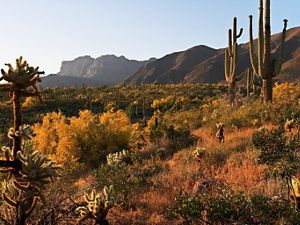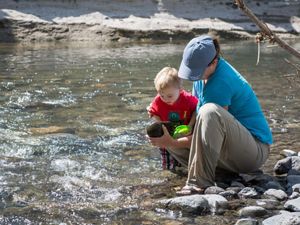The Nature Conservancy, Partners Protect Water for People and Nature with Landmark Easement
Media Contacts
-
Jody Norris
Protection Program Director
Email: jody.norris@tnc.org -
Tracey Stone
Media Relations
Email: tstone@tnc.org
A landmark conservation easement covering 1,889 acres of vital ranchland in Big Chino Valley has closed, marking a significant step in the region’s land and water conservation efforts. This agreement, made in partnership between Yavapai Ranch, The Nature Conservancy (TNC) and Natural Resources Conservation Service (NRCS), is the first easement of its kind to be completed in the area.
Unregulated groundwater pumping, development and climate change have negatively impacted the Big Chino Aquifer, a groundwater basin located in north-central Arizona primarily within Yavapai County. This critical resource provides a future water supply for the communities of Prescott, Prescott Valley and Chino Valley. It also supports the Verde River—which irrigates farms and provides recreational opportunities for people.
The Yavapai Ranch conservation easement is a voluntary agreement that limits development and associated groundwater withdrawals from the Big Chino Aquifer, while preserving agricultural use. The conservation easement incentivizes managing water use at existing levels and continuing agricultural best management practices. By collaborating with the landowner, this protection will help maintain the region’s delicate water balance and ensure that the grasslands remain a home for birds and wildlife.
Land Advisors Organization (LAO) and Hermitage Land Co. represented the landowner. LAO’s Conservation Division partnered with TNC to secure Farm Bill funding for the project. They also designed a broader conservation easement program that focuses on preserving agriculture and a flowing Upper Verde River by ensuring there is enough water in the right place at the right time for people and nature amidst warmer and drier weather.
“We’re grateful to our ranching partner for collaborating with us on this easement, said Jody Norris, TNC Land Protection Director. “By working together, we’re able to protect water, wildlife, grasslands and preserve the family’s ranching business.”
This easement is part of a broader conservation strategy in northern Arizona and is supported by the Regional Conservation Partnership Program. The RCPP—which has provided a $23 million dollar grant for this work—is designed to protect water resources, preserve local agricultural land and resilient grasslands and promote sustainable land management practices in Big Chino Valley, northwest of Prescott.
“Land Advisors Organization worked with The Nature Conservancy and conservation partners to design the RCPP and a conservation easement program as a framework that provides a locally led solution to rural groundwater management. This partnership has provided a much-needed alternative to state-mandated regulation,” said Heather Reading, Conservation Division Leader for Land Advisors Organization. “I’m thrilled that our clients at Yavapai Ranch were the first landowners to participate in the program and demonstrate leadership in resource management.”
The historic Yavapai Ranch is one of the oldest continually operating cattle ranches in Arizona, having been homesteaded in 1868. The conservation easement is over 1,889 acres on the eastern edge of the ranch that skirts the Big Chino Valley grasslands, one of the largest intact native grasslands in Arizona. These high-quality grasslands support one of the state’s largest remaining herds of pronghorn antelope—an Arizona wildlife species of concern due to impacts of grassland conversion and habitat fragmentation. The ranch is within the Grand Canyon to Prescott Corridor Complex, identified by Arizona Game and Fish as critical for all wildlife given that this area has the highest future potential for fragmentation and development in the state.
Additionally, the conservation easement lies atop the western edge of Big Chino Aquifer. The aquifer is located outside of an Active Management Area (AMA), which means that groundwater withdrawals are not regulated in any way. Thus, it is at risk of depletion from residential development, municipal pumping and the increasing threat of large-scale commercial crop farms.
The headwaters of the Verde River emerge from perennial springs fed by the Big Chino Aquifer and the upper river is almost entirely dependent on the aquifer for baseflow. Flows from the 195-mile Verde River are a lifeblood for Arizona. The Verde River supports abundant native fish and wildlife. It supports the tri-cities of Prescott, Prescott Valley and Chino Valley that depend on groundwater from its aquifers. Downstream communities of the Verde Valley depend on the river for irrigated agriculture and river recreation that drives tourism and economic prosperity. Even further downstream, the Verde River provides a critical source of drinking water for over 5 million people in metropolitan Phoenix.
About Land Advisors Organization:
Land Advisors Organization is the nation’s largest land brokerage and advisory firm, specializing in large-acreage transactions and conservation easements that balance land development with sustainability. The firm’s advisors work with landowners and purchasers to provide a comprehensive and effective evaluation of land in markets across the United States.
The Nature Conservancy is a global conservation organization dedicated to conserving the lands and waters on which all life depends. Guided by science, we create innovative, on-the-ground solutions to our world’s toughest challenges so that nature and people can thrive together. We are tackling climate change, conserving lands, waters and oceans at an unprecedented scale, providing food and water sustainably and helping make cities more sustainable. The Nature Conservancy is working to make a lasting difference around the world in 81 countries and territories (40 by direct conservation impact and 41 through partners) through a collaborative approach that engages local communities, governments, the private sector, and other partners. To learn more, visit nature.org or follow @nature_press on X.



